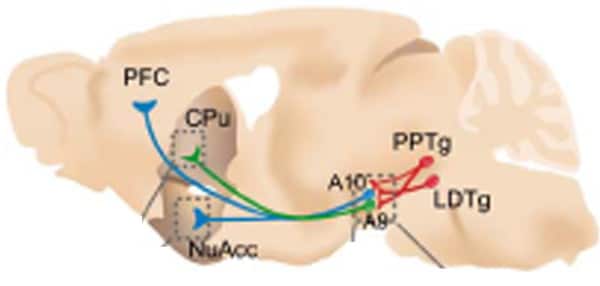The neurotransmitter dopamine is involved in a broad range of brain functions, including motor activity, cognition and reinforcement. Midbrain dopaminergic (DA) ascending pathways have been classically divided into two major tracts: i) The nigrostriatal pathway projects from the Substantia Nigra pars compacta (SNpc; A9 cell group) to the dorsal striatum and is primarily involved in the regulation of motor activity; its degeneration in humans leads to Parkinson’s Disease (PD). ii) The meso-corticolimbic tract projects from the Ventral Tegmental Area (VTA; A10) to the Nucleus Accumbens (NuAcc) of the ventral striatum, limbic areas and prefrontal cortex (PFC) and is mainly implicated in cognition, reward-based learning and addiction. Over the past 40 years the DA system has been the focus of intense research, particularly due to its relationship with PD and drug addiction. Today, the basic aspects of DA control over the basal ganglia are well understood, however, little information is available on the regulation of DA neurons by various other neurotransmitters acting on the midbrain DA nuclei and their striatal projections. Recent evidence suggests an important role of acetylcholine (ACh) in the regulation of DA activity. The cholinergic afferences from the Pedunculopontine Tegmental Nucleus (PPTg) and the Laterodorsal Pontine Tegmental Nucleus (LDTg) innervate the SNpc and VTA nuclei, respectively. Additionally, cholinergic interneurons in the ventral and dorsal striatum provide a further anatomical and functional basis for the interaction of ACh with DA pathways (see Fig. 1). Further evidence suggests that nicotinic ACh receptors containing the β2 subunit (β2*-nAChRs) are implicated in the cholinergic action over DA activity: β2*-nAChRs are present in the VTA and SNpc of all mammals, both in the soma of DA nuclei as well as in GABAergic interneurons, and also at the terminal of DA striatal projections. We have recently described the regulation of the firing pattern of DA neurons in vivo through somato-dendritic β2*-nAChRs in anaesthetized mice (1). In addition, striatal cholinergic interneurons are known to exert a local control over DA release, mainly through the activation of presynaptic β2*-nAChRs in DA terminals. Previous studies have shown the involvement of β2*-nAChRs in various types of DA mediated behaviors including those associated with the reinforcing properties of nicotine originating from their activity within the VTA (2). However, a main question that remains to be addressed is the direct participation of β2*-nAChRs in the control of DA-mediated spontaneous locomotor activity. Mice lacking functional β2*-nAChRs (β2KO) show a striking hyperactive phenotype, displaying enhanced navigation and decreased exploration in the open field(3), evidence of a deficit in behavioral flexibility. Our hypothesis is that this feature reflects an imbalance of DA neurotransmission at meso-corticolimbic and/or nigrostriatal pathways. Given the classical view of the anatomical and functional dissociation of the two major ascending DA pathways, we tested the specific contribution of endogenous ACh via β2*-nAChRs to the locomotor behaviors regulated by each of these systems in vivo. To this end, we performed a targeted lentiviral genetic rescue of functional β2*-nAChRs in the SNpc or the VTA of β2KO mice and quantified the behavioral outcome of this selective restoration.
Life Sciences 2007 (2007) Proc Life Sciences, SA116
Research Symposium: Nicotinic receptors control dopamine-mediated locomotor behaviors
U. Maskos1, P. Faure1, J. Changeux1, M. E. Avale1
1. Institut Pasteur, Paris, France.
View other abstracts by:
Where applicable, experiments conform with Society ethical requirements.

